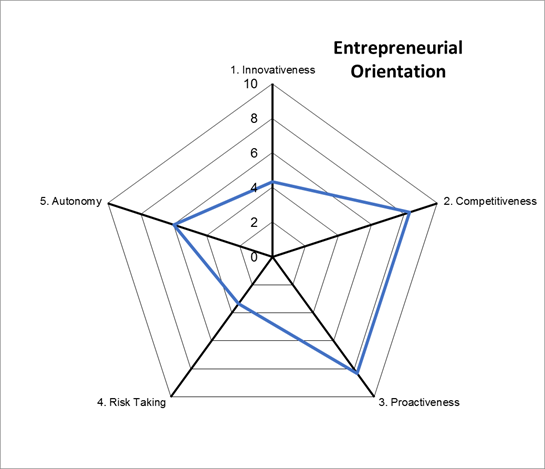Topic outline
-
-
Task
Read Lumpkin and Dess (1996), access the case study and perform an entrepreneurial orientation assessment.
Learning Outcome
After completing this task you should be able to:
- explain how innovation connects with entrepreneurial orientation
- explain the key dimensions of entrepreneurial orientation
- explain the relationship between entrepreneurial orientation and business performance
- appraise how equipped a business is to support entrepreneurial activity
Due
End of Week 1.
Note
This task will give you a new way to look at a business in a critical and structured manner. Its greatest value is that it provides a snapshot of the characteristics and capabilities of a business to support entrepreneurial activity.
This task utilises a questionnaire that is designed to measure entrepreneurial orientation within an organisation. The results are shown in the form of a radar chart (aka spider chart, web chart and star plot) that gives you the profile of the business in terms of the five entrepreneurial orientation dimensions. The strengths of a business are shown as a result line nearest to the outer edge of the results chart.

Entrepreneurial Orientation Radar Chart
If you were to do this exercise outside of your studies, your assessment would be based on whatever information is available. This may be information on the website of the business such as an annual report, from your own personal contact with the business, from conversations with staff and/or from conversations with people (e.g. customers) who deal with that business.
Suggested Procedure
- Before reading, consider the following:
- How could you (or the management team) foster all five dimensions of entrepreneurial orientation in your workplace?
-
Reading length: 13 pages (Dimensions of an Entrepreneurial Orientation)
Read Lumpkin, GT & Dess, GG 1996, ‘Clarifying the entrepreneurial orientation construct and linking it to performance', Academy of Management Review, vol. 21, no. 1, pp. 138-152
- Respond to the following:
- How positive is the relationship between entrepreneurial orientation and business performance? Do all dimensions impact equally?
- The entrepreneurial orientation construct does not take into consideration any moderating and/or mediating factors. What is the likely impact of the environmental and organisational variables listed on p. 152 of Lumpkin and Dess (1996)?
- Risk taking and competitive behaviours could be viewed as negative in certain circumstances. How might this play out within an organisation? Are there any potential costs associated with lifting the dimensions?
- How do you embed entrepreneurial culture into the DNA of an existing business? How might you roll out this change without upsetting staff? Can it be done without hiring new staff with appropriate skills and/or cultural fit?
- Access your selected case study:
- Case study 1.1: Social Entrepreneurship
- Case study 1.2: Technology Innovation and Commercialisation
- Case study 1.3: Corporate Entrepreneurship
- Case study 1.4: Family Business
- Using the Entrepreneurial Orientation Diagnostic spreadsheet, assess the entrepreneurial orientation of the enterprise.
- Use the information provided in the case that you are given and answer as best you can the questions relating to each of the dimensions
- You might find it useful to search for additional information about the business to help you to form an opinion about how to answer each question
- Form an assessment of the degree to which you would agree with a number of propositions
- Enter an appropriate numerical score in the shaded boxes provided. We use a numerical scale where 0 = strongly disagree and 10 = strongly agree
- When you have answered each question to the best of your ability the results will be displayed on the ‘results chart’ worksheet
- Post a summary of your assessment (i.e. copy and paste an image of your radar chart into the editor and upload a copy of your spreadsheet with your numerical responses) and responses to the question outlined above to the Learning Task 1.4 Forum.
- It is important to appreciate that the assessment is subjective, so after posting compare your assessment with that of others who have analysed the same organisation.
- Did your peers’ perspectives vary significantly? How reliable is it as a diagnostic tool?
- Comment on at least two posts that arrived at different conclusions from your own. Be sure to analyse their numerical response and request their underlying rationale.
- Be sure to reply to any comments and/or questions on your postings.
- The course teaching team will be facilitating discussions during the week and will summarise the key ideas after everyone has had a chance to respond.
Reading
Lumpkin, GT & Dess, GG 1996, ‘Clarifying the entrepreneurial orientation construct and linking it to performance', Academy of Management Review, vol. 21, no. 1, pp. 138-151
-